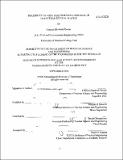Feasibility of very deep borehole disposal of US nuclear defense wastes
Author(s)
Dozier, Frances Elizabeth
DownloadFull printable version (14.78Mb)
Other Contributors
Massachusetts Institute of Technology. Dept. of Nuclear Science and Engineering.
Advisor
Michael J. Driscoll.
Terms of use
Metadata
Show full item recordAbstract
This thesis analyzes the feasibility of emplacing DOE-owned defense nuclear waste from weapons production into a permanent borehole repository drilled ~4 km into granite basement rock. Two canister options were analyzed throughout the thesis: the canister currently used by the DOE for vitrified defense waste and a reference canister with a smaller diameter. In a thermal analysis, the maximum temperatures attained by the rock surrounding the waste, waste form, canister, liner, and gaps during the post-emplacement period were calculated. From this data, simple analytic equations were formed that can be used to calculate the maximum temperature differences for both defense waste and spent fuel when one does not want to repeat the analysis. Canister corrosion and waste form dissolution analyses were performed using Pourbaix diagrams. Finally, the cost and time for drilling the borehole and emplacing the defense waste were calculated. The temperature change in the granite is 15.1°C for the reference canister and 45.7°C for the DOE Canister. The resulting maximum temperature at the bottom of the borehole is 135.1°C (reference canister) and 165.7°C (DOE canister) for the bounding defense waste. The centerline temperature for the borosilicate glass waste package is approximately 150°C for the reference canister and 207°C for the DOE canister. Because of the thermodynamic properties, overall corrosion resistance, and reasonable cost, pure copper was shown to be the best borehole outer canister material. High-chromium stainless steel could also be a good option for borehole canisters because it has been shown to be highly corrosion-resistant in environments similar to predicted borehole environments. Cesium ion was found to have the highest concentration in the borehole environment. However, the relatively low half life of the most abundant cesium isotope suggests that the cesium would decay before the canister is breached. For the reference canister, the drilling and emplacement costs are not expected to exceed $46/kg of vitrified waste and the total disposal cost was found to be $153/kg of vitrified waste. The total cost of disposal of defense waste in DOE containers is not expected to exceed $53/kg of vitrified waste. Based on these analyses, disposal of vitrified defense waste in deep boreholes is expected to be technically and economically feasible.
Description
Thesis (S.M.)--Massachusetts Institute of Technology, Dept. of Nuclear Science and Engineering, 2011. Cataloged from PDF version of thesis. Includes bibliographical references (p. 171-176).
Date issued
2011Department
Massachusetts Institute of Technology. Department of Nuclear Science and EngineeringPublisher
Massachusetts Institute of Technology
Keywords
Nuclear Science and Engineering.